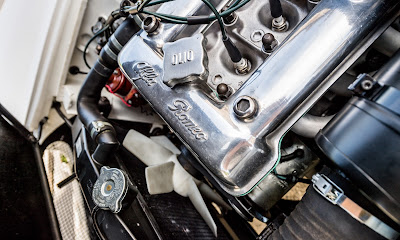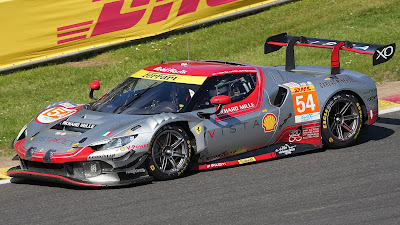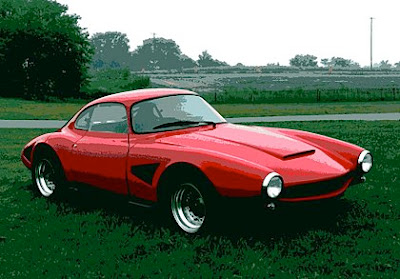Unique ONES - When discussing iconic custom cars from Hollywood, the name George Barris inevitably comes to mind. Barris was a visionary in the world of automobile customization, and his creations often stole the spotlight in television and film during the 1960s. Barris' work not only redefined what a car could be, but also connected the entertainment industry with custom vehicles, creating a lasting legacy. One of his lesser-known, but equally intriguing creations is the 1975 "Eldorette," a one-of-a-kind Corvette modified with parts from a Cadillac Eldorado for the legendary actor John Belushi.
 |
| The 1975 Eldorette, a one-of-a-kind Corvette modified with parts from a Cadillac Eldorado for the legendary actor John Belushi.. (Picture from: BarnFinds) |
The
Eldorette is a rare artifact of a very particular time in car customization, when the audacious and the extravagant were the standards of the day. Originally based on
a Corvette C3, this vehicle's history is tied closely to
George Barris and his unmistakable approach to car design. Known for turning conventional vehicles into remarkable, one-of-a-kind automobiles,
Barris' touch on the
Eldorette is unmistakable. The car was heavily modified with a variety of elements that transformed its look completely, blending parts from
a Cadillac Eldorado to create something truly unique.
 |
| The 1975 Eldorette, a one-of-a-kind creation by Barris, was heavily modified with Cadillac Eldorado parts, completely transforming its look. (Picture from: DezzysSpeedShop in Facebook) |
The story of this Corvette begins with its commission by John Belushi,
the iconic comedian and actor best known for his role in The Blues Brothers. Although details about
Belushi’s time with the car remain scarce, its subsequent history offers some insights. After
Belushi, the
Eldorette found its way into a collection owned by
John Foster, where it remained until his death in
1995. From there, it was sold at an estate sale and eventually reappeared on the market, currently seeking a new owner.
 |
| Vintage car enthusiasts will appreciate details like the chrome side pipes and Erson dress-up valve covers, both popular features in custom cars of this era. (Picture from: BarnFinds) |
As for the car itself, the modifications performed by
Barris are nothing short of eye-catching. The fenders and rear quarters were reshaped and extended upward, giving the
Eldorette a bulkier, more dramatic profile. The rear was designed in a continental style,
featuring a Lincoln emblem—an unusual choice that only adds to the vehicle's distinctiveness. Interestingly, the taillights are reminiscent of those from
an AMC Gremlin, adding yet another layer of quirkiness to its design. The front end of the car was also customized, adding a unique flair that sets it apart from
any typical Corvette.
 |
| The 1975 Eldorette's interior appears to be well-preserved. Its condition, combined with the car’s rarity, makes it an appealing collector’s item, especially for those interested in Hollywood history or Barris’ body of work. (Picture from: BarnFinds) |
Under the hood, the Eldorette retains a 350 engine, with little else known about its drivetrain. The transmission is automatic. Vintage car enthusiasts will appreciate details like the chrome side pipes and Erson dress-up valve covers, which were common features in custom cars from this era. The mileage is reportedly 24,500, although the odometer has rolled over, hinting at the car’s extensive use over the decades.
 |
| Under the hood, the Eldorette features a 350 engine and an automatic transmission, though details about the rest of the drivetrain remain limited. (Picture from: BarnFinds) |
The interior of the Eldorette, based on the few available images, appears to be well-preserved. Its condition, combined with the car’s rarity, makes it an appealing collector’s item, especially for those interested in
Hollywood history or
Barris’ body of work. The
T-Top panels, a classic feature of many
Corvettes, are likely stored behind the seats in the luggage compartment, another nod to its practicality despite its wild appearance.
 |
The 1975 Eldorette features T-Top panels, a classic Corvette element likely stored behind the seats in the luggage compartment, adding practicality to its wild appearance. (Picture from: BarnFinds)
|
For car collectors or enthusiasts looking for something that stands out, the
Eldorette offers an intriguing opportunity.
With an asking price of $24,999 (in September, 2023), the vehicle is a piece of history that could serve as a conversation starter at any car show or event. The seller has even floated the possibility of a trade, showing interest in another head-turning vehicle that isn’t a project car. For those in the market for a one-of-a-kind custom car with celebrity provenance, this might just be the gem they’ve been searching for.
 |
| The
1975 Eldorette is undeniably eye-catching, with reshaped fenders and
rear quarters extended upward, giving it a bulkier, more dramatic
profile. (Picture from: DezzysSpeedShop in Facebook) |
Yet, for all its divisiveness, the Eldorette is undoubtedly a testament to George Barris’ creativity and willingness to push boundaries. It’s a car that elicits strong reactions—whether of admiration or confusion—and that’s precisely what makes it so fascinating. As one of the few remaining relics of the custom car era of the 1970s, the Eldorette stands as a symbol of the bold experimentation that characterized automotive culture at the time.

In the end, the
Eldorette might not be to everyone's taste, but it is undeniably a unique piece of history. Whether you view it as a work of art or an automotive oddity, its connection to
both George Barris and John Belushi ensures that it will always hold a special place in the annals of custom car culture. For the right buyer, it represents not only a rare opportunity but a piece of Hollywood’s eccentric past brought to life on four wheels.
*** [EKA | FROM VARIOUS SOURCES | BARNFINDS | CORVETTEBLOGGER | CORVETTEFORUM | DEZZYS SPEEDSHOP IN FACEBOOK ]
Note: This blog can be accessed via your smart phone

 The story of this iconic vehicle offers a fascinating insight into the golden age of Italian car manufacturing and the innovative spirit that defines the Alfa Romeo brand. The Giulia Sprint Speciale traces its origins back to the Alfa Romeo Giulietta, which was introduced in 1954. The Giulietta represented a groundbreaking achievement in design and performance during its era. Equipped with a 1290cc twin-cam engine, this model provided an exhilarating driving experience with its lightweight and agile handling.
The story of this iconic vehicle offers a fascinating insight into the golden age of Italian car manufacturing and the innovative spirit that defines the Alfa Romeo brand. The Giulia Sprint Speciale traces its origins back to the Alfa Romeo Giulietta, which was introduced in 1954. The Giulietta represented a groundbreaking achievement in design and performance during its era. Equipped with a 1290cc twin-cam engine, this model provided an exhilarating driving experience with its lightweight and agile handling. 







 As Alfa Romeo forges ahead into the future, the spirit of the Giulia Sprint Speciale remains alive in its modern offerings. These classic models serve as a reminder of the brand's rich heritage and its commitment to creating vehicles that blend style, speed, and sophistication. Whether showcased at car shows or enjoyed on the open road, the Giulia Sprint Speciale stands as a symbol of timeless automotive excellence and a celebration of the passion that drives the world of motorsport. *** [EKA | FROM VARIOUS SOURCES | WIKIPEDIA | ICONICAUCTIONEERS | MOTORMUSEUM | SUPERCARS.NET | ART&REVS ]
As Alfa Romeo forges ahead into the future, the spirit of the Giulia Sprint Speciale remains alive in its modern offerings. These classic models serve as a reminder of the brand's rich heritage and its commitment to creating vehicles that blend style, speed, and sophistication. Whether showcased at car shows or enjoyed on the open road, the Giulia Sprint Speciale stands as a symbol of timeless automotive excellence and a celebration of the passion that drives the world of motorsport. *** [EKA | FROM VARIOUS SOURCES | WIKIPEDIA | ICONICAUCTIONEERS | MOTORMUSEUM | SUPERCARS.NET | ART&REVS ]

































